Recent Storm Damage Posts
Flood Barriers and Sandbags: Effective Techniques for Flood Defense
1/8/2024 (Permalink)
Floods pose a significant threat to both residential and commercial properties, causing extensive damage and disruption. Fortunately, there are effective techniques available to mitigate flood-related risks. In this blog, we will explore two popular flood defense methods: flood barriers and the use of sandbags. Understanding the benefits and proper implementation of flood barriers and sandbags can help individuals and communities better protect themselves against the destructive forces of flooding.
The Role of Flood Barriers
- Understanding the purpose and benefits of flood barriers in flood defense strategies.
- Exploring different types of flood barriers, including temporary, demountable, and permanent options.
- Highlighting the versatility of flood barriers, as they can be customized to fit various structures and landscapes.
Types of Flood Barriers
- Detailing the features and applications of common flood barriers such as inflatable, self-closing, and modular systems.
- Discussing the advantages of each type, including quick deployment, ease of maintenance, and cost-effectiveness.
- Showcasing real-life examples of successful flood barrier installations and their impact on flood mitigation.
Understanding Sandbags as a Flood Defense Technique
- Highlighting the traditional and widely-used approach of using sandbags as a temporary flood defense measure.
- Explaining the benefits of sandbags, such as their availability, affordability, and ease of use.
- Providing step-by-step instructions on proper sandbag placement and stacking techniques to maximize their effectiveness.
Best Practices for Sandbag Deployment
- Addressing the importance of planning and preparation before a flood event, including estimating the number of sandbags required.
- Providing safety guidelines for handling sandbags and ensuring they are properly filled and securely placed.
- Discussing the potential limitations of sandbags and when additional flood defense measures may be necessary.
Supplementary Flood Defense Measures
- Highlighting the benefits of combining flood barriers and sandbags with other flood mitigation strategies, such as landscaping modifications and water-resistant building materials.
- Exploring the use of floodproof doors, non-return valves, and flood-resistant coatings in flood-prone areas.
- Encouraging individuals and communities to consult with professionals specializing in flood defense to determine the most effective combination of techniques for their specific needs.
Implementing effective flood defense techniques is crucial for protecting lives, property, and infrastructure in flood-prone areas. Flood barriers, both temporary and permanent, along with the use of sandbags, offer practical and reliable methods to minimize flood-related risks.
By understanding the benefits, proper implementation techniques, and supplementary measures available, individuals and communities can significantly enhance their resilience when faced with the relentless power of flooding. Remember, proactive planning and collaboration with flood defense professionals are key to building a robust flood defense strategy that reduces the impact of floods on our lives.
Safeguarding Older Homes from Storm Damage in the St. Louis
9/12/2023 (Permalink)
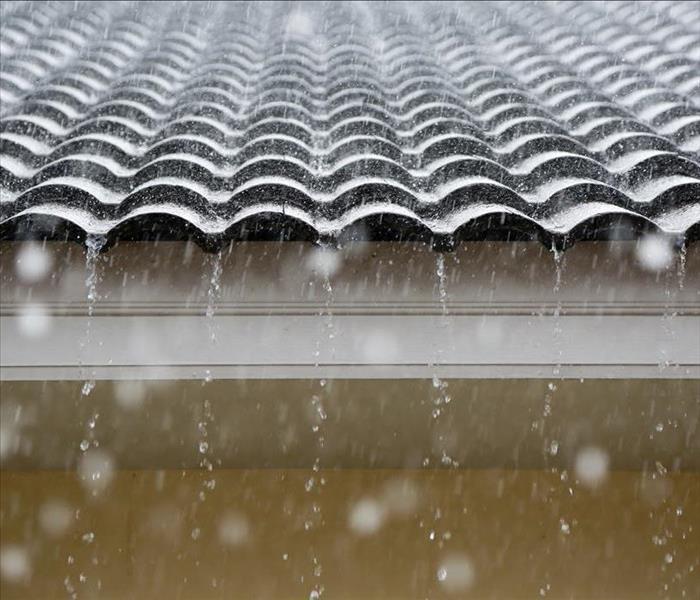 Before delving into protective measures, it's essential to identify vulnerabilities that older homes might face during storms.
Before delving into protective measures, it's essential to identify vulnerabilities that older homes might face during storms.
Nestled within the historic charm of the St. Louis area are older homes that tell stories of a bygone era. While these homes exude character and nostalgia, they may be more susceptible to storm damage due to aging structures and materials. In this blog, we'll explore actionable steps to protect older homes from the wrath of storms, helping you preserve the beauty of the past while fortifying against the challenges of the present.
Recognizing Vulnerabilities
Before delving into protective measures, it's essential to identify vulnerabilities that older homes might face during storms:
Outdated Materials: Aging roofs, windows, and siding may not provide the same level of protection as modern alternatives.
Foundation Issues: Settling or deterioration of the foundation can lead to water intrusion during heavy rainfall.
Weakened Structure: Over time, the structural integrity of an older home may be compromised, making it susceptible to wind damage.
Inadequate Drainage: Older homes might lack proper drainage systems, increasing the risk of flooding and water damage.
Fortifying Your Home
Roof Inspection and Maintenance: Regularly inspect the roof for loose shingles, leaks, and signs of wear. Reinforce the roof with updated materials if needed.
Windows and Doors: Seal gaps around windows and doors to prevent water intrusion. Consider upgrading to impact-resistant windows if appropriate.
Siding Reinforcement: Replace damaged siding and consider adding weather-resistant siding materials for better protection.
Foundation Inspection: Address any foundation issues promptly to prevent water infiltration. Consider waterproofing measures.
Gutter Maintenance: Keep gutters clear of debris to ensure proper water drainage away from the home's foundation.
Tree Trimming: Trim overhanging branches and trees near your home to prevent potential damage during storms.
Insurance Considerations
Review your homeowner's insurance policy to understand the coverage for storm damage. Consider adding endorsements that cater to the unique needs of older homes.
Historic Preservation
If your home is designated as a historic property, consult local preservation guidelines before making any modifications. There may be regulations that affect the types of upgrades you can undertake.
Regular Maintenance
Consistent upkeep is key to protecting older homes. Regular inspections and proactive maintenance can prevent small issues from escalating into major problems.
Final Thoughts
Owning an older home in the St. Louis area is a privilege that comes with responsibility. By understanding the vulnerabilities and taking proactive steps, you can ensure that your historic treasure stands strong against the forces of nature. Preserving the past while embracing modern protective measures allows you to enjoy the charm of your older home while safeguarding its future for generations to come.
5 Effective Ways to Prevent Flooding in Your Home
6/14/2023 (Permalink)
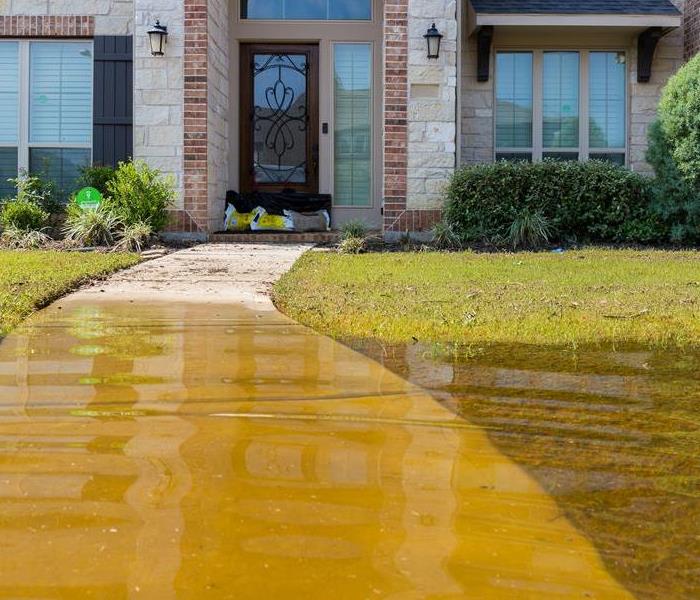 If you do experience flooding, it's important to act quickly to minimize the damage.
If you do experience flooding, it's important to act quickly to minimize the damage.
Flooding can be a major problem for homeowners, causing significant damage to property and potentially putting lives at risk. While it's not always possible to prevent flooding from occurring, there are steps you can take to minimize the damage and reduce the risk of it happening in the first place. Here are five effective ways to prevent flooding in your home:
Keep gutters and downspouts clean and clear
One of the primary causes of flooding is clogged gutters and downspouts. When debris accumulates in these areas, it can prevent water from draining properly and cause it to overflow. Regularly cleaning and clearing your gutters and downspouts can go a long way in preventing flooding.
Install a sump pump
Sump pumps are an essential tool in preventing flooding. They work by pumping excess water out of your home and away from the foundation. Installing a sump pump can be a wise investment to protect your property from water damage.
Use landscaping to your advantage
Landscaping can play a crucial role in preventing flooding. Planting trees and shrubs strategically can help absorb excess water and prevent it from pooling in areas around your home. Additionally, grading your lawn away from your foundation can help prevent water from seeping into your basement.
Seal any cracks and gaps
Small cracks and gaps around windows, doors, and foundations can be entry points for water. Sealing these areas can help prevent water from seeping into your home and causing damage.
Consider a backflow preventer
If you live in an area prone to heavy rainfall or flooding, installing a backflow preventer can be a smart move. This device works by preventing water from flowing back into your home's plumbing system, which can be a common cause of flooding.
By taking these five steps, you can significantly reduce the risk of flooding in your home and protect your property from damage. However, if you do experience flooding, it's important to act quickly to minimize the damage. Contacting a professional restoration company like ours can help ensure that your home is restored to its pre-flood condition and that any potential mold growth is addressed.
What to Expect After Winter Storm Damage
12/1/2022 (Permalink)
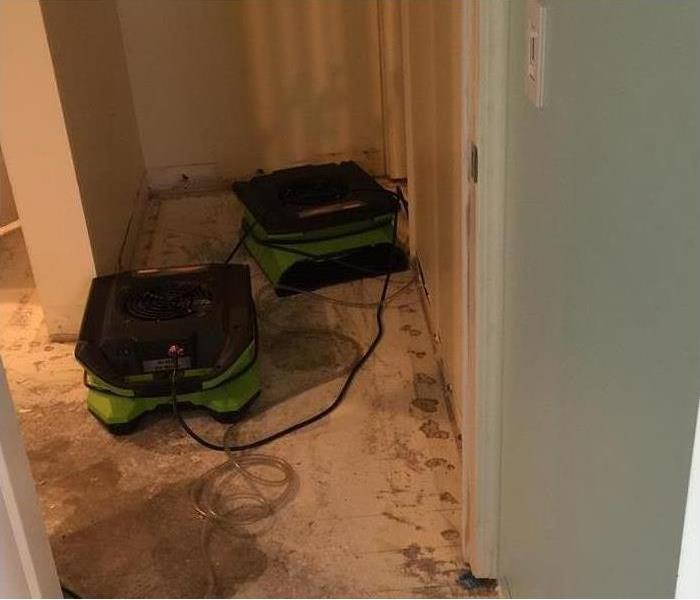 Drying out an area that was affected by floodwaters in Fernridge, MO.
Drying out an area that was affected by floodwaters in Fernridge, MO.
What To Do After Water Damage From a Storm
After a winter storm in Fernridge, MO you may be at a loss. If your home has been damaged, you may be unsure of where to go from there. The best defense against storm damage is to be prepared in advance, and information is key. From water removal to what you may need to tear out, here are four steps to follow after water damage from a storm:
1. Extract Water
First and foremost, following a winter storm that has resulted in flooding, you need to extract the water. You can utilize the help of professional service to remove the water from your home so that you can begin the storm restoration.
2. Tear Out Wet Contents
Wet materials cannot stay in your home. Mold grows quickly. Within the first couple of days, you could have a serious mold situation on your hands. To avoid that or to guarantee that it doesn’t get worse, you should remove all wet contents as quickly as possible. This could be clothing, furniture or even drywall that is damaged beyond repair. Tear out anything that is wet and will not dry within the house.
3. Dry Out Flooded Area and Contents
You can lay out your contents in the sun to dry while waiting for the inside of your home to dry up also. Inside, you can utilize fans and dehumidifiers to rid it of moisture. Most people prefer investing in a dehumidifier to help rid the inside of any extra moisture.
4. Restore Home
Once you tear out any of the furniture or components of the house that is damaged beyond repair, you can work on restoring your home.
While laying out the steps seems simple, dealing with an actual flood can be a challenge. With the help of a restoration specialist, you can clean and build your home back to the way it was quickly and efficiently
Protect Your Business’s Roof With 3 Simple Tips
9/15/2022 (Permalink)
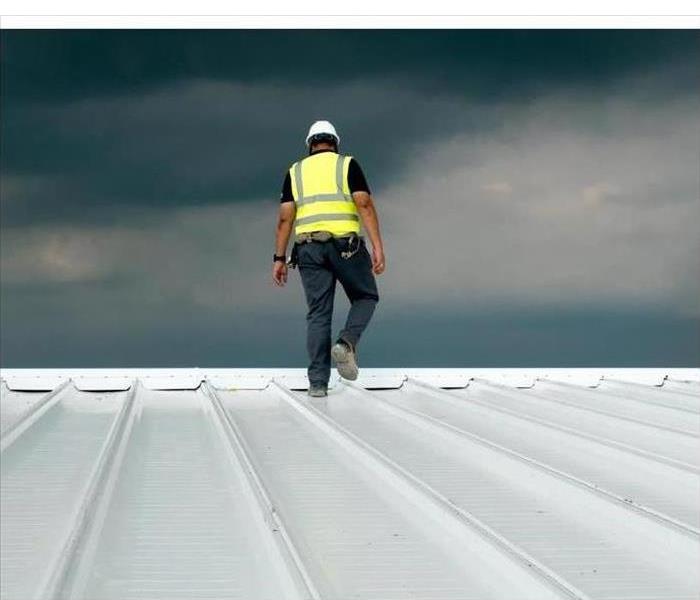 Schedule routine inspections.
Schedule routine inspections.
Roof Damage Containment
If you are like most business owners, you probably think very little about the roof that covers your building. Nonetheless, if your roofing system springs a leak or otherwise fails, the damage to your company’s inventory and equipment can be significant. To avoid a catastrophe, you must work to contain roof damage.
1. Trim Overhanging Branches
You can’t control the weather. When a thunderstorm or tornado rolls through, wind damage can be extensive. While you can’t keep shingles from blowing off the roof of your business, you can keep overhanging branches from falling onto your building. By regularly trimming trees and removing other debris, you decrease the chances that a falling limb may crash through your company’s roof.
2. Schedule Routine Inspections
Roofs are funny things. Often, roof damage takes years to reveal itself. When it does, it may be too late to repair the roofing system. If you are worried about the condition of the roof over your business, schedule regular inspections. For new roofs, having a technician take a look every three or four years is likely sufficient. For older ones, ask someone to crawl on the roof every year or so.
3. Replace Old, Damaged, or Ineffective Roofs
Damaged roofs are dangerous. As such, scheduling a roof rebuild is simply something you can’t afford to delay. Replacing your company’s roof with a modern one is an effective way to protect the equipment and inventory inside your buildings. It is also a good way to safeguard your employees and customers.
Even with your best efforts, you may not be able to completely avoid roof damage. If your building’s roof springs a leak, the contents of your buildings may sustain considerable damage. Fortunately, a reputable restoration service in Creve Coeur, MO, can likely help you with clean-up. Still, to increase your odds of avoiding disaster, you must spend a bit of time thinking about your business’s roof.
What To Do When Disaster Strikes
9/6/2022 (Permalink)
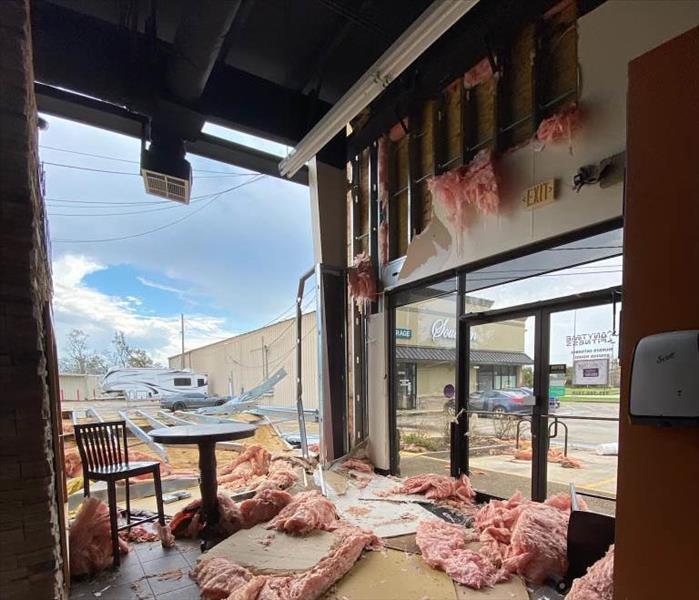 Disasters can never be fully anticipated, but there are key steps that can be taken to mitigate the impact.
Disasters can never be fully anticipated, but there are key steps that can be taken to mitigate the impact.
Preparing for the Storm
Disasters are costly, often dangerous, and may require 24 hour assistance. Here are some steps to take when dealing with a disaster that will help you limit damage to your property and recover as quickly as possible.
1. Plan Ahead To Ensure a Fast Response
You are more likely to respond to a disaster quickly and efficiently if you make a plan ahead of time. Homeowners should inform their family or roommates of the disaster plan, taking care to practice key steps with children when necessary. Business owners should develop a disaster procedure and train employees to follow it. Be aware of the entrances and exits to your building, and display egress maps prominently in high traffic areas. Create a list of contact information for emergency services, community disaster resources, and 24 hour building restoration services.
2. React Appropriately
While some disasters are not immediately dangerous, all disasters increase the likelihood of danger. If you find yourself in a dangerous situation, the most important step is removing yourself from harm’s way. Once you are safe, inform those around you of the danger and report the disaster to emergency services.
Some disasters do not require emergency services. In these instances, assess the damage and determine what you can do to limit the spread of the disaster. This may mean moving undamaged items to a secondary location or making temporary repairs to your property. Be sure to document damage thoroughly for insurance purposes.
3. Repair and Restore
Whether you’re dealing with a leaking roof in your home or a kitchen fire in your St. Louis, MO, restaurant, restoring damage quickly is essential. SERVPRO is always open, with 24 hour cleaning and restoration services standing by to assist you. Customers will receive a call within an hour after initial contact. Personnel can be on site within 4 hours and can supply verbal instructions about your next steps within just 8 hours.
Disasters are stressful and even dangerous, but having a plan and responding appropriately can limit long-term damage and help you prepare to restore your property.
Restoring Your Home in the Aftermath of a Storm
7/2/2022 (Permalink)
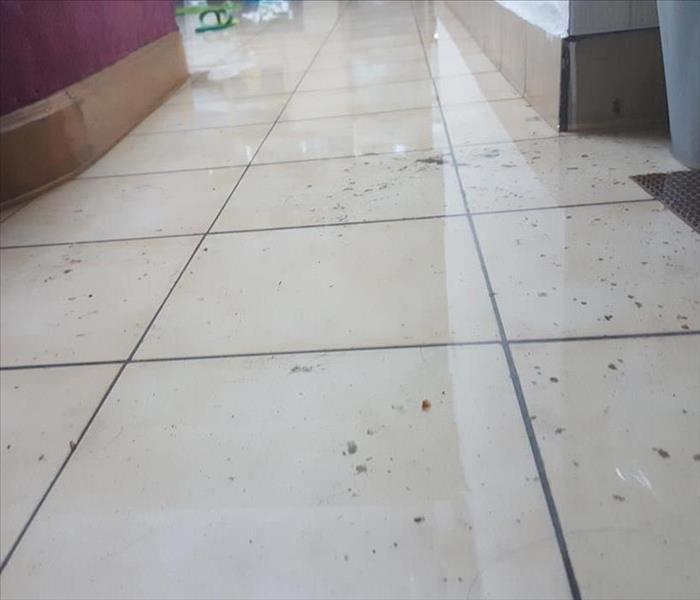 Severe storms may cause sewage backups in your home.
Severe storms may cause sewage backups in your home.
Storm Tips
The aftermath of a storm in Chesterfield, MO, can be devastating in many ways. In addition to inflicting immediate damage to your home, storms can cause water buildup in your home, leading to long-term problems. A damage restoration team can help you get your home back in working order, and there are also storm tips that you can use to safeguard against further harm.
Identifying Contaminated Water
Severe storms may cause sewage backups and broken pipelines and flood your home with contaminated water. Being able to identify the type of water in your home can help you maintain your safety. There are several types of contamination, including:
Clean water - uncontaminated water that may still promote bacterial or mold growth if left untreated
Gray water - contaminated water that may lead to discomfort and illness
Blackwater - severely contaminated water that could lead to illness and/or death
Storm damage comes in many forms and can even extend past the immediate harm inflicted on your home. As any list of storm tips will point out, it is important to be cautious in handling sewage backups in your home. In addition to identifying the category of contamination, you can protect yourself by using professional services to rid your home of tainted water. A properly trained technician has the tools and expertise to safely dispose of the water.
Safely Documenting Damage
When it is safe to do so, return to the house to thoroughly document the extent of the damage. Documentation helps the restoration team know what needs to be done to get your home back to its optimal condition.
In addition to flooding, the house may also become a breeding ground for mold and other safety hazards. At the top of the list of a storm, tips are strategies for maintaining your own safety. Your well-being should be prioritized. If possible, try to stay with friends or family until your home is properly restored.
Clearing Drains and Gutters Before a Flood
6/2/2022 (Permalink)
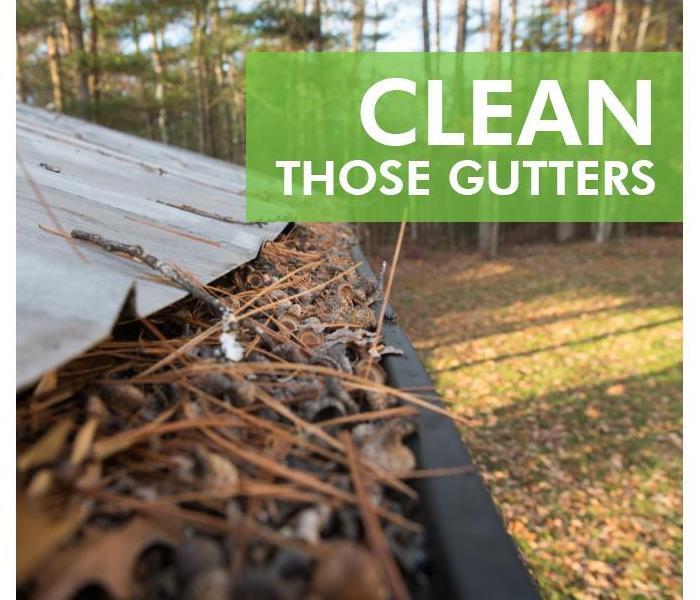 Twice a year, clean your gutters.
Twice a year, clean your gutters.
Prevent Flood Damage To Your Home
Before flooding hits Maryland Heights, MO you have the power to take action and lessen potential harm to your home. It is especially important to ensure excess water can easily drain away in a storm. At any time of year, leaves and debris can pile up in gutters and on top of storm drains, so be sure to always keep them clean. Following these simple steps while the sky is still clear can help prevent the worst of future flood damage.
1. Twice a year, clean your gutters. This approach is a great way to avoid severe flooding. Each spring and fall, remove the covers from dry gutters. Put on gloves, and use your hands or a small tool to brush away debris. With your hose, run water through the cleared gutter to confirm uninterrupted flow. Don’t forget to rake up leaves and debris and put them in a proper container when you’re done.
2. Practice another gutter etiquette. This includes fixing leaky gutters, either yourself or with the help of a professional. You should also direct gutter downspouts away from your foundation and your neighbors’ properties.
3. Keep leaves and sticks in a yard waste bin. Yard debris left lying loose on your land can quickly end up in drains. This will exacerbate any flooding caused by a storm and lead to more problems in the long run.
4. Take time to check storm drains for debris piled on top. If you notice leaves and debris lying on the surface of storm drains, act rapidly to remove them with a rake or broom. As always, put everything you collect into a yard waste bin or another container.
Storm damage in Maryland Heights, MO often includes floods, one of the worst disasters that can strike your home. In addition to taking smart steps after a flood, such as calling restoration professionals, use the above list now to keep gutters and drains clear and ready to do their job in a storm.



 24/7 Emergency Service
24/7 Emergency Service





